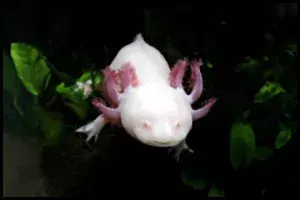
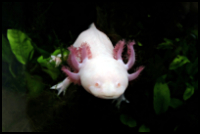
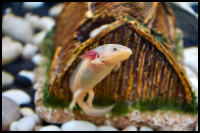
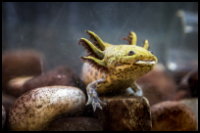
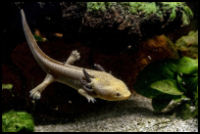

Quick Care Details (Table)
| Livestock Characteristics | Value |
|---|---|
| Care Level | Moderate |
| Temperament | Peaceful |
| Diet | Carnivore |
| Maximum Size | 12 Inches |
| Minimum Tank Size | 20 Gallons |
| Plant Safe | Yes |
| Temperature Range | 60-68F |
| PH Range | 6.5-8.0 |
| KH Range | 4-8 |
| GH Range | 6-12 |
Species Specific Categories
Helpful Video
Care Details
Hiding Places: Provide plenty of hiding spots using decorations, caves, and live or artificial plants. Axolotls are naturally shy and nocturnal creatures, so they need places to retreat and feel secure.
Lighting: Axolotls prefer low to moderate lighting levels. Use subdued lighting or provide shaded areas in the tank to reduce stress. Avoid bright and intense lighting, which can be uncomfortable for axolotls.
Water Changes: Perform regular partial water changes of around 20% every one to two weeks to maintain water quality and remove toxins. Dechlorinate tap water with a suitable water conditioner before adding it to the tank.
Handling: Minimize handling and use a gentle touch when necessary. Wet your hands before handling axolotls to avoid damaging their skin, as they have delicate and sensitive skin.
Substrate: Choose a soft substrate, such as sand or fine gravel, to prevent injury and ingestion. Avoid rough or sharp substrates that can harm the axolotl's skin or cause digestive issues if accidentally consumed.
Temperament and Behavior
- Axolotls are generally peaceful and non-aggressive creatures.
- They are not known to exhibit aggressive behaviors towards humans or other tank mates.
- Axolotls are relatively calm and slow-moving, spending much of their time exploring their environment or resting.
- They are not social animals and prefer a solitary lifestyle, so they can be housed alone without the need for companionship.
- While they are not aggressive towards most tank mates, it's important to choose compatible tank mates that won't nip at or harass the axolotl's delicate skin or disturb them during resting periods.
- Axolotls have poor eyesight but are sensitive to vibrations and movements in the water, so sudden and fast movements may startle them.
- They have a gentle temperament and can become accustomed to being hand-fed, though it's important to handle them with care to avoid injuring their delicate skin and limbs.
- Occasionally, axolotls may exhibit territorial behavior, particularly during breeding or if their hiding spots are invaded. Providing ample hiding spots and territories can help reduce potential conflicts.
- Stressful conditions, such as poor water quality, excessive noise or vibrations, or incompatible tank mates, can lead to behavioral changes or potential health issues. It's important to create a suitable and stress-free environment for axolotls.
Diet and Nutrition
- Axolotls are carnivorous and primarily eat meat-based foods.
- Feed axolotls a varied diet of live or frozen meaty foods, such as bloodworms, brine shrimp, daphnia, blackworms, and small fish. Offer food items that are appropriately sized and avoid overfeeding to prevent obesity.
- Feed axolotls two to three times a week, adjusting the frequency based on their age, size, and activity level.
- Only feed them an amount they can consume within 5 to 10 minutes to avoid overfeeding and water quality issues.
- Use feeding tools, such as tweezers or feeding tongs, to place the food directly in front of the axolotl's mouth to ensure they can locate and consume it.
- Consider gut-loading live foods with nutritious supplements before offering them to axolotls to enhance their nutritional value.
- Occasionally introduce small amounts of plant matter to provide dietary fiber, such as blanched spinach or finely chopped earthworms.
- Avoid feeding axolotls large food items that may cause choking or impact their digestive system.
- Remove any uneaten food from the tank to prevent it from decomposing and affecting water quality.
- Observe the axolotl's body condition and adjust feeding amounts accordingly to maintain a healthy weight.
Tank Parameters
Tank Size: Provide a spacious tank with a minimum size of 20 gallons (75 liters) for a single adult axolotl. Larger tanks are recommended for multiple axolotls or to allow for more swimming space.
Water Temperature: Axolotls are cold-water amphibians and prefer cooler temperatures between 60°F and 68°F (15°C and 20°C). Avoid exposing them to temperatures above 72°F (22°C), as higher temperatures can be stressful and harmful to their health.
pH: Axolotls prefer slightly alkaline to neutral water conditions. The recommended pH range for axolotls is between 6.5 and 8.0. It's important to maintain a stable pH within this range to prevent fluctuations that can stress the axolotls.
KH (Carbonate Hardness): Axolotls can tolerate a moderate carbonate hardness level. The ideal KH range for axolotls is between 4 and 8 degrees. Carbonate hardness helps stabilize pH levels and prevents rapid pH fluctuations.
GH (General Hardness): Axolotls are adaptable to a range of general hardness levels. The preferred GH range for axolotls is between 6 and 12 degrees. General hardness refers to the concentration of minerals, particularly calcium and magnesium, in the water.
Tank Size: Provide a spacious tank with a minimum size of 20 gallons (75 liters) for a single adult axolotl. Larger tanks are recommended for multiple axolotls or to allow for more swimming space.
History, Popularity, History and Species Variety Details
History and Popularity of the Cute Axolotl
The axolotl, scientifically known as Ambystoma mexicanum, has a fascinating history that stretches back thousands of years. These unique aquatic salamanders are native to the ancient lakes of Xochimilco and Chalco in Mexico, which were once part of the vast network of waterways in the Valley of Mexico. The axolotl's name originates from the Aztec Nahuatl language, with "atl" meaning water and "xolotl" referring to the Aztec god of deformations and death.
The axolotl played a significant role in Aztec mythology and culture. The Aztecs believed that the axolotl was a powerful and sacred creature. They saw the axolotl's ability to regenerate lost body parts as a symbol of rebirth and transformation, associating it with their god Xolotl, who was believed to have the power to change shape and transform into various forms. Due to this sacred connection, axolotls were revered and considered spiritual entities.
In modern times, axolotls have gained popularity worldwide, primarily for their unique characteristics, remarkable regenerative abilities, and captivating appearance. Their popularity can be seen in various aspects:
- Scientific Research: Axolotls have become a significant subject of scientific research, particularly in the fields of developmental biology, genetics, and regenerative medicine. Their extraordinary ability to regenerate entire limbs, spinal cord, heart, and even parts of their brain has made them valuable models for studying tissue regeneration and understanding the underlying mechanisms behind this process. Scientists are fascinated by the axolotl's regenerative abilities and hope to unlock the secrets that could potentially be applied to human medical advancements, such as tissue engineering and regenerative therapies.
- Captivating Pets: Axolotls have also gained popularity as captivating pets in the aquarist community. Their unique appearance, with fringed external gills, beady eyes, and permanent smiles, makes them visually appealing and endearing. They come in a range of colors, including wild-type, leucistic, albino, and melanoid variations, which adds to their aesthetic appeal. The ease of caring for axolotls, their low-maintenance requirements, and the ability to keep them in a fully aquatic environment have made them attractive options for both experienced and novice aquarium enthusiasts.
- Online Communities and Social Media: The advent of social media platforms has contributed to the growing popularity of axolotls. Online communities and forums dedicated to axolotls have emerged, providing platforms for enthusiasts to share their experiences, knowledge, and photos of their axolotls. Social media platforms like Instagram, TikTok, and YouTube are filled with captivating videos and images showcasing the unique behaviors and antics of axolotls. This exposure has helped spread awareness and further popularize these fascinating creatures.
- Conservation Efforts: As the popularity of axolotls has grown, so has the awareness of their declining population in the wild. The remaining wild populations of axolotls in Mexico are critically endangered due to habitat loss, pollution, and the introduction of non-native species. Conservation organizations and researchers are working to protect and restore their natural habitats, as well as promote captive breeding programs to maintain healthy populations and genetic diversity.
In summary, the history of axolotls is deeply rooted in Aztec mythology and their sacred status. In modern times, their popularity has soared due to their remarkable regenerative abilities, scientific significance in research, unique appearance, and their popularity as captivating pets. The combination of their cultural significance, scientific value, and endearing qualities has made axolotls beloved creatures that continue to intrigue and captivate people worldwide.
Male gender vs Female gender (Sexual Dimorphism)
- Look for size differences: Males tend to be slightly larger and longer than females, especially when they reach sexual maturity.
- Examine the tail base: Males typically have a thicker tail base compared to females.
- Check for cloacal differences: The cloaca is the opening for both reproductive and excretory functions. In males, the cloaca is usually more prominent and swollen compared to females.
- Observe courtship behavior: During breeding season, males may display courting behaviors such as nudging the female's head or vibrating their tails.
- Check for the presence of papillae: Males may have small, pointed structures called papillae located behind their cloaca. These are absent in females.
- Consult an experienced breeder or veterinarian: If you're unsure about the gender of your axolotl, seek guidance from an experienced axolotl breeder or a veterinarian with expertise in amphibians. They can help you accurately determine the gender.
How to breed Cute Axolotl
- Prepare the breeding tank: Set up a suitable tank for breeding axolotls. Ensure the tank size is at least 20 gallons per adult axolotl, and it has appropriate filtration and aeration systems. Maintain water parameters within the recommended range (temperature: 16-18°C or 60-64°F, pH: 6.5-8.0).
- Determine the gender: Axolotls are sexually dimorphic, so you need to identify the gender of your axolotls. Males typically have thicker tail bases and more prominent cloacas compared to females. Separate the males and females until you're ready to breed.
- Condition the axolotls: Feed the breeding pair a high-quality diet to ensure they are in good health and optimal breeding condition. Offer a varied diet of live or frozen foods such as bloodworms, brine shrimp, or blackworms.
- Introduce the breeding pair: Once the axolotls are mature (usually around 12-18 months), introduce the male and female into the breeding tank. Ensure the tank has plenty of hiding spots, such as caves or plants, to provide security for the axolotls.
- Observe courtship behavior: Watch the axolotls closely for courtship behavior. Males may display courting behaviors like nudging the female's head or vibrating their tails. The male may also deposit spermatophores (sperm packets) on various surfaces within the tank.
- Stimulate breeding behavior: To encourage breeding behavior, you can try simulating seasonal changes. Lower the water temperature by a few degrees or increase the photoperiod (light exposure) in the tank. This can mimic the transition from winter to spring and trigger breeding behavior in axolotls.
- Provide a suitable egg-laying site: Once mating occurs, the female will lay eggs. Provide broad-leaved plants, spawning mops, or a clean surface where the female can deposit her eggs. Ensure the surface is easy to remove for egg collection later.
- Remove the adult axolotls: After the eggs are laid, promptly remove the adult axolotls from the breeding tank to prevent them from consuming the eggs or disturbing the nest. Place them back into their separate tanks.
- Incubate the eggs: Transfer the eggs to a separate container filled with clean water from the breeding tank. Maintain appropriate water conditions, including temperature, pH, and gentle aeration. Avoid direct light exposure to the eggs.
- Monitor and care for the eggs: Monitor the eggs closely for signs of fungus or infertile eggs, which should be removed promptly. Keep the water clean and maintain optimal conditions. The eggs will hatch in approximately 14-21 days, depending on the water temperature.
- Feed the hatchlings: Once the eggs hatch, the larvae (fry) will emerge. Initially, they will survive off their yolk sacs, but after a few days, you can start providing them with small live foods like baby brine shrimp or daphnia. Gradually introduce them to commercial axolotl pellets as they grow.
- Separate and raise the fry: As the fry grow, separate them into individual containers or larger tanks to prevent overcrowding. Provide suitable filtration and maintain appropriate water parameters. Continue feeding them a balanced diet and monitor their growth and overall health.
Frequently Asked Questions
What is an axolotl?
An axolotl is a type of salamander native to Mexico. It is known for its unique appearance, with external gills, a fringed head, and the ability to retain its larval features throughout its life.
Can axolotls regenerate their body parts?
Yes, they are famous for their remarkable regenerative abilities. They can regenerate lost limbs, spinal cord, heart tissue, and even parts of their organs.
What do axolotls eat?
Axolotls are carnivorous and primarily feed on live or frozen foods. Their diet typically includes small invertebrates like bloodworms, brine shrimp, daphnia, and blackworms. Commercial axolotl pellets can also be offered as a staple food.
How big do axolotls grow?
Axolotls can vary in size, but on average, they reach a length of about 9-12 inches (23-30 cm) when fully grown. Males tend to be slightly larger than females.
Can axolotls live together in the same tank?
Axolotls can live together, but it's important to consider factors such as tank size, compatibility, and individual personalities. Providing adequate space and hiding spots can help reduce stress and potential aggression.
Do axolotls need a heater?
Axolotls are cold-water amphibians and prefer cooler temperatures between 16-18°C (60-64°F). They do not require a heater unless the room temperature consistently falls below their preferred range.
Do axolotls require a filter?
Yes, axolotls benefit from having a filter in their tank. A good filtration system helps maintain water quality by removing waste and keeping ammonia and nitrate levels in check. However, it's important to choose a filter that creates a gentle water flow to avoid stressing the axolotls.
Can axolotls breathe outside of the water?
Axolotls are entirely aquatic and rely on their gills to breathe. While they can survive for short periods out of water, it's essential to keep their gills moist and ensure they have access to water for extended periods.
How long do axolotls live?
With proper care, axolotls can live for 10-15 years or even longer. Providing a suitable environment, a balanced diet, and regular monitoring of their health can help promote a long lifespan.
Can axolotls change their color?
Axolotls come in various colors, including wild-type (dark brown/green), albino (pink with red gills), and various color morphs. While they cannot change their color dramatically, factors such as age, health, and environmental conditions may affect their color intensity.
How often should I feed my axolotl?
Axolotls should be fed 2-3 times a week as adults. Offer them a portion of food that they can consume within 5-10 minutes. Adjust the feeding frequency based on their appetite and overall condition.
Can axolotls live in a tank with other fish or aquatic animals?
Axolotls generally do not coexist well with most fish species, as they have a tendency to nip at the fins of smaller tank mates. They can be housed with certain compatible species, such as non-aggressive, larger fish or other axolotls.
What type of substrate should I use in my axolotl's tank?
It is recommended to use a bare-bottom tank or a tank with a fine sand substrate. Avoid using gravel or small substrates that the axolotl can accidentally ingest, which can lead to intestinal blockages.
How often should I clean the axolotl tank?
Regular maintenance is important to keep the axolotl tank clean. Perform partial water changes of around 20-25% every 1-2 weeks, and siphon any excess waste or debris from the substrate. Monitor water parameters and adjust the cleaning frequency as needed.
Can axolotls be housed in an outdoor pond?
While axolotls are typically kept in indoor tanks, they can be housed in outdoor ponds if certain conditions are met. The pond should provide a suitable environment with stable water temperature, appropriate filtration, and protection from predators, extreme weather, and direct sunlight.
What are some common health issues that axolotls may experience?
Axolotls can be susceptible to health issues such as bacterial or fungal infections, skin shedding problems, metabolic disorders, and parasitic infestations. Regularly monitor their behavior, appetite, and physical condition, and seek veterinary care if you notice any signs of illness.
Can axolotls be kept in a planted tank?
Axolotls can be kept in a planted tank, but it's important to choose plants that are compatible with their needs. Avoid using sharp or delicate plants that can harm the axolotl or be uprooted easily. Hardy, low-light plants like Java fern, Anubias, or Marimo moss balls are often suitable options.
How often do axolotls shed their skin?
Axolotls shed their skin periodically as they grow. The frequency of shedding can vary but typically occurs every few weeks to a couple of months. During shedding, the axolotl's skin may appear dull or opaque, and they may rub against objects to help remove the old skin.
Are axolotls legal to own as pets in all countries?
Axolotl ownership regulations vary by country and even within different regions. It is essential to research and comply with local laws and regulations regarding the ownership, import, or trade of axolotls before acquiring them as pets.
Can axolotls be kept in a brackish water environment?
Axolotls are primarily freshwater creatures and are best suited for freshwater aquariums. They should not be kept in a brackish water environment, as it can be detrimental to their health and well-being.

